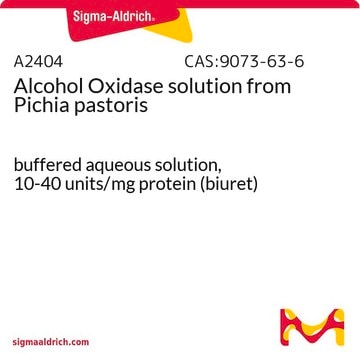おすすめの製品
アプリケーション
D-fructose dehydrogenase is used as a biosensor to detect the presence of D-fructose.
Fructose dehydrogenase (FDH) is used in a number of basic research projects to examine the electrochemical properties of enzyme-catalyzed electrode reactions called bioelectrocatalysis. D-fructose dehydrogenase has been used in a study that contributed towards a convenient method for measuring rare sugars, monosaccharides, for applications in the bio-industry. A direct electron transfer reaction of d-fructose dehydrogenase adsorbed on a porous carbon electrode surface has been used to describe a batch-type coulometric d-fructose biosensor.
生物化学的/生理学的作用
D-fructose dehydrogenase catalyzes the oxidation of D-fructose to 5-keto-D-fructose.
Fructose dehydrogenase (FDH) is a heterotrimeric membrane-bound enzyme commonly seen in various Gluconobacter sp. especially in Gluconobacter japonicus (Gluconobacter industrius). It has a molecular mass of ca. 140 kDa, consisting of subunits I (67kDa), II (51 kDa), and III (20 kDa) and catalyzes the oxidation of D-fructose to produce 5-keto-D-fructose. The enzyme is a flavoprotein-cytochrome c complex with subunits I and II covalently bound to flavin adenine dinucleotide (FAD) and heme C as prosthetic groups, respectively.
単位の定義
1ユニットは、pH 4.5、37°C、1分間で、1.0 μmolのD-フルクトースを5-ケトフルクトースに変換する酵素量です。
物理的形状
クエン酸-リン酸バッファー塩、TRITON® X-100と安定剤を含有する凍結乾燥粉末
保管分類コード
11 - Combustible Solids
WGK
WGK 3
引火点(°F)
Not applicable
引火点(℃)
Not applicable
個人用保護具 (PPE)
Eyeshields, Gloves, type N95 (US)
適用法令
試験研究用途を考慮した関連法令を主に挙げております。化学物質以外については、一部の情報のみ提供しています。 製品を安全かつ合法的に使用することは、使用者の義務です。最新情報により修正される場合があります。WEBの反映には時間を要することがあるため、適宜SDSをご参照ください。
Jan Code
F5152-BULK:
F5152-50UN:
F5152-3X250UN:
F5152-250UN-PW:
F5152-250UN:
F5152-VAR:
F5152-1KU:
試験成績書(COA)
製品のロット番号・バッチ番号を入力して、試験成績書(COA) を検索できます。ロット番号・バッチ番号は、製品ラベルに「Lot」または「Batch」に続いて記載されています。
Seiya Tsujimura et al.
Analytical chemistry, 81(22), 9383-9387 (2009-11-17)
This paper describes a batch-type coulometric d-fructose biosensor based on direct electron transfer reaction of d-fructose dehydrogenase (FDH) adsorbed on a porous carbon electrode surface. The adsorbed-FDH electrodes catalyzed the electrochemical two-electron oxidation of d-fructose to 5-keto-d-fructose without a mediator.
Ana Dominguez et al.
Revista iberoamericana de micologia, 23(3), 189-191 (2007-01-02)
Several microorganisms are reported to have transfructosylation activity due to fructosyltransferase and/or fructofuranosidase activities. However, the search for other fungi with higher transfructosylation activity remains a challenge. So, a presumptive and indirect colorimetric plate assay for the evaluation of transfructosylation
Takeo Miyake et al.
Journal of the American Chemical Society, 133(13), 5129-5134 (2011-03-12)
Nanostructured carbons have been widely used for fabricating enzyme-modified electrodes due to their large specific surface area. However, because they are random aggregates of particular or tubular nanocarbons, the postmodification of enzymes to their intrananospace is generally hard to control.
Amperometric flow injection determination of fructose with an immobilized fructose 5-dehydrogenase reactor.
K Matsumoto et al.
Analytical chemistry, 58(13), 2732-2734 (1986-11-01)
S Kadow et al.
Biotechnology and bioengineering, 91(2), 154-161 (2005-05-26)
A biosensor for fructose determination was used as basis of an assay for the determination of glucosyltransferase (GTF) activities and applied to monitoring recombinant enzyme production. GTFs catalyze the synthesis of glucans from sucrose leading to the release of fructose.
ライフサイエンス、有機合成、材料科学、クロマトグラフィー、分析など、あらゆる分野の研究に経験のあるメンバーがおります。.
製品に関するお問い合わせはこちら(テクニカルサービス)






